2021 January 2
Jeremy Tatum writes: It’s pouring with rain today, but we can still look at a few invertebrates. Here are two moth pupae:
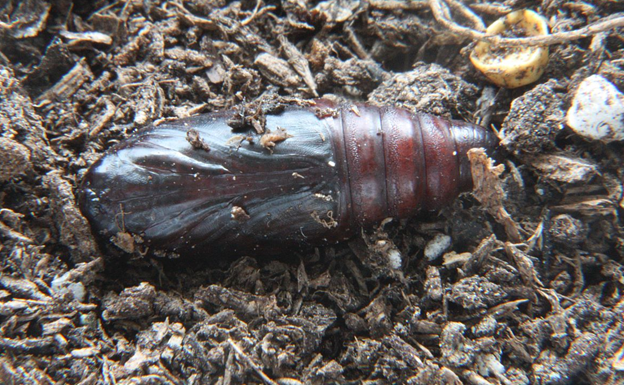
Egira crucialis (Lep.: Noctuidae) Jeremy Tatum
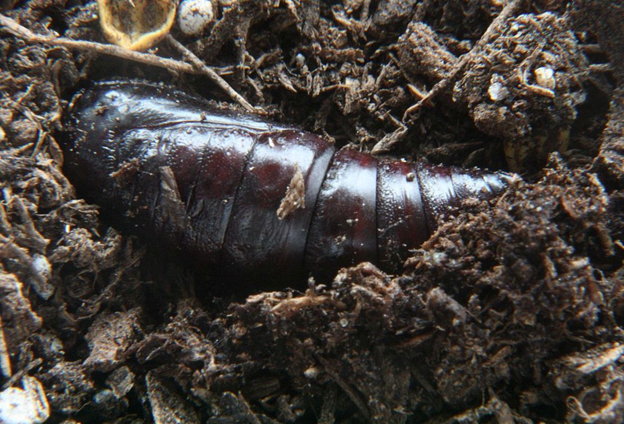
Biston betularia (Lep.: Geometridae) Jeremy Tatum
2021 January 2
Jeremy Tatum writes: It’s pouring with rain today, but we can still look at a few invertebrates. Here are two moth pupae:

Egira crucialis (Lep.: Noctuidae) Jeremy Tatum

Biston betularia (Lep.: Geometridae) Jeremy Tatum
2020 BUTTERFLY REPORT FOR
SOUTHERN VANCOUVER ISLAND
Jeremy Tatum
This short unofficial report is a summary of butterfly observations made in 2020 within the southern Vancouver Island birdwatching area and submitted to the Victoria Natural History Society’s Invertebrate Alert Website:
I am not planning to produce a printed version, but if anyone would like one, let me know (jtatum at uvic dot ca) and I’ll see what I can do.
This report does not (apart from one or two brief mentions of particular interest) include the many butterfly observations reported from Vancouver Island in 2020 outside the area described above (for full definition, see any issue of the Annual Bird Report). Nor does it include the results of the Monthly Butterfly Counts organized by Gordon Hart, which cover the area of the Victoria Christmas Bird Count Circle. These are published by Gordon in the 2021 January/February issue of the Victoria Naturalist. It is hoped that this report, as well as the Monthly Count data, will give readers some idea of the dates when and places where our several butterflies can be found.
The year 2020 was extraordinary in the very small number of almost all species of butterfly. It was one of the worst years for butterflies in the area that I remember.
HESPERIIDAE – Pyrginae
PROPERTIUS DUSKYWING
Erynnis propertius
There were only six reports, all of single butterflies, during the period April 15 to May 27. The areas where they were reported from were Mount Tolmie, Highlands, Metchosin, Goldstream Park. This cannot have been the total number of butterflies in the area – doubtless others were seen but not reported. Nevertheless, numbers must have been very much down compared with a typical year. A late sighting from Nanaimo River Road on June 17 was outside the area covered by the report.
[ROADSIDE SKIPPER
Amblyscirtes vialis
Although this report covers only the area described above, the sighting of a Roadside Skipper by Mark Wynja and Mike Yip on NW Bay logging Road, Nanoose, on June 28, is sufficiently noteworthy to make this exception.]
[TWO-BANDED GRIZZLED SKIPPER
Pyrgus ruralis
As in 2018, no reports of this species were received by Invert Alert this year, and there was only one in 2019. This small butterfly is easy to miss; nevertheless it seems that it must now be regarded as a rarity in our area.]
HESPERIIDAE – Heteroptinae
ARCTIC SKIPPER
Carterocephalus palaemon
This species has long been rare within the boundaries of our area, so it is good to record that one was seen along the railway line north of Cowichan Station on May 5.
HESPERIIDAE – Hesperiinae
ESSEX SKIPPER
Thymelicus lineola
This European species is one of the most abundant butterflies in the area. Reports were from June 17 to August 4. On June 24, 46 were counted in Panama Flats and a further 11 in Layritz Park. During a VNHS field trip perhaps hundreds – too many to count – were seen in Layritz Park. “Many” – presumably meaning too many to attempt an accurate count – were reported from Metchosin on July 10, and in Uplands Park, Oak Bay, on July 12.
[BRANDED SKIPPER
Hesperia comma
In this Report, the “Western” Branded Skipper (treated as a distinct species by some authors) is included under Hesperia comma. Because of the Covid-19 virus, the Tsawout First Nation requested non-members not to walk through their property this year, a request that was readily adhered to by butterfly watchers. Thus we had no reports of the Branded Skipper this year.]
WOODLAND SKIPPER
Ochlodes sylvanoides
The first report was of one seen during a VNHS field trip on July 6. There were no further reports until July 23, when a single was reported from Metchosin. After that, two were reported on August 1, and the species was seen thereafter throughout August, although the great majority of these were reported from Metchosin, where they were common. In the Victoria area, judging from the number of reports sent to Invert Alert, they were remarkably scarce, a total of only 14 reported from Victoria and the Saanich Peninsula during August. Several remained in scattered localities until September 8, plus one late single seen in Beacon Hill Park on September 24.
DUN SKIPPER
Euphyes vestris
One was seen and photographed on June 28 by Ron Flower on the way to the Kinsol Trestle. This species (officially “At Risk”) was once regular (though uncommon) near the Kinsol Trestle, although its habitat suffered disturbance during the restoration of the trestle. It is good to know that it still occurs there. On the same date, Mark Wynja and Mike Yip saw one in Nanoose, outside the area covered by the Report.
PAPILIONIDAE – Parnassiinae
CLODIUS PARNASSIAN
Parnassius clodius
Outside the area covered by this report, there were sightings and photographs from Nanaimo River Road, the Matterhorn (Shirley), and in the Sooke Hills. Within our area, there was only one possible sighting, on May 27. However, see Rocky Mountain Parnassian.
ROCKY MOUNTAIN PARNASSIAN
Parnassius smintheus
A Parnassian was photographed by Ron Flower along the railway line at Cowichan Station on May 27. There is some uncertainty as to whether it was Parnassius clodius or P. smintheus. However, I am listing it here under smintheus. The photograph can be seen on Invert Alert for May 27 evening. If this is indeed smintheus (as seems likely although not certain), perhaps sightings of parnassians from this location in previous years and recorded under clodius might actually have been smintheus. Butterfliers are asked to take careful note of parnassians seen at Cowichan Station next year. Larval foodplants of both species (Bleeding Heart for clodius, Stonecrop for smintheus) are common there.)
PAPILIONIDAE – Papilioninae
ANISE SWALLOWTAIL
Papilio zelicaon
One was seen on Mount Tolmie on April 16. No further reports until May 13. There were 11 sightings from May 13 – June 18, nine of them from Metchosin. One was seen on Mount Douglas May 19. and one at Island View Beach on June 2. There was a late sighting at Island View Beach on September 8. At least five caterpillars were found feeding on Oenanthe sarmentosa in Bow Park, Saanich, on September 18.
WESTERN TIGER SWALLOWTAIL
Papilio rutulus
First reported from Francis/King Park on May 16, a very (record?) late start for the season. After that it was regular, but not often in large numbers, until the last reported sighting on July 24. The largest counts reported on a single day were 6-8 at Duncan sewage lagoons on June 17, and an encouraging 34 at Royal Roads University on July 20. Other than that, although there were reports on most days, never more than three were reported on a single day. A pupa (which would have been formed by a caterpillar in 2019) was found by Robb Bennett on May 21, from which the adult successfully emerged on May 27. A second-instar caterpillar was found on Ocean Spray (an uncommon foodplant) near Munn Road on June 22. Its final instar pupated on August 1. The pupa will overwinter.
PALE TIGER SWALLOWTAIL
Papilio eurymedon
Reported from May 15 to July 10, plus one late one on Jul 29. Seven were reported on May 27 (six from the Kinsol Trestle, and one from Goldstream Heights), and five were reported from Kemp Lake on June 1. Other than that, all reports from within our area were of just one or two per day.
PIERIDAE – Pierinae
PINE WHITE
Neophasia menapia
Reported from July 20 to September 8, plus one late one at Beechey Head on September 21. The first report, on July 20, was also the largest one of the year – 28 at Royal Roads University and nearby. About 20 were reported from various locations from July 22 to August 3. After that, from August 9 to September 8, all sightings except one were from Metchosin, the species apparently being absent elsewhere. In Metchosin, however, it was regular during that period, with up to a dozen seen on most days.
MARGINED WHITE
Pieris marginalis
All sightings were from the railway line north of Cowichan Station, as follows:
Three on each of May 15, 18 and 28. Six on August 16.
CABBAGE WHITE
Pieris rapae
Of those butterflies that do not spend the winter as adult insects, the Cabbage White was the first (March 25) and last (October 22) butterfly species reported during the year. From April 1 to 18, there were just seven reports of single butterflies. The species was seen daily from April 19 to the end of July, though only a few reported on most days. The only larger counts during that period were of 10 at Mount Douglas on April 20, 25 there on May 19, and 34 at Royal Roads University and nearby on July 20.
Only five were reported during August. Possibly observers were losing interest in reporting them, or it is also likely their numbers really were falling off during August. Butterflies of all sorts were so scarce during September that observer interest in reporting Cabbage Whites was restored, and the species was reported throughout September – mostly in quite small numbers, although a dedicated count on September 21 showed 38 in the Martindale Valley. (In most years, hundreds, or even thousands, are reported from that area.) A few Cabbage Whites lingered during the first eight days of October. After that, two were reported on October 20, and another two on October 22, for the last butterflies of the year other than those nymphalids that overwinter as adults.
PIERIDAE – Anthocharinae
SARA ORANGETIP
Anthocharis sara
Reports of this short-lived (in the adult state) harbinger of spring were from April 6 to May 18. Most reports were from the Munn Road area amd Metchosin. Other reports were from Christmas Hill, Mount Tolmie, Mount Douglas and Cowichan Station.
PIERIDAE – Coliadinae
SULPHUR
Colias
There are three possible species in our area. The Western Sulphur Colias occidentalis is resident in parts of Vancouver Island, but it is rarely seen in our area. The Orange Sulhpur C. eurytheme is a migratory species that occasionally occurs here, sometimes in good numbers, usually late in the year, September or October. It is possible or even probable that in good Orange Sulphur years there are also a few Clouded Sulphurs C. philodice. Sulphurs are not easy to identify to species.
2020 was not a good sulphur year; there were, however, two reports. One was seen by Val George in the parking lot at Goldstream Park, a butterfly, remarks Val, that he wouldn’t have expected in that habitat. While this butterfly could not be identified with certainty, in view of the date, it is not unreasonable to suspect that it may have been occidentalis. At any rate, this is certainly a species to look out for.
A sulphur was photographed by Mike McGrenere at McIntyre Reservoir, Central Saanich on September 20, and probably the same one was seen again there by Ron Flower on September 22. A photograph and discussions about the identity are to be found on the Invertebrate Alert for these dates. It is thought to be most probably an Orange Sulphur.
LYCAENIDAE – Lycaeninae
PURPLISH COPPER
Lycaena helloides
Scarce this year. All reports received were. May 20, one, Cordova Spit. May 27, two, Kinsol Trestle. June 1, one at Island View Beach. One there, July17. Two there, September 8.
LYCAENIDAE – Theclinae
CEDAR HAIRSTREAK
Mitoura rosneri
Very scarce indeed this year. One or sometimes two were reported on several dates from May 16 to June 21 at Gordon Hart’s property in the Highlands, and one was reported from Metchosin on May 26. No further reports were received by Invertebrate Alert, and some observers, including this compiler, did not see the species during the year.
WESTERN BROWN ELFIN
Incisalia iroides
This normally very common butterfly was even scarcer than the previous species. The only reports received were of two on Mount Tolmie, April 8, and two along the Gorge Road, April 12.
MOSS’S ELFIN
Incisalia mossii
One and one only sighting of this species was reported to Invertebrate Alert – one in the Highlands, April 12.
While it is possible that this and the previous two species were overlooked or for some reason under-reported, it can scarcely be doubted that it was a disastrous year for all three.
WESTERN PINE ELFIN
Incisalia eryphon
This species is normally not at all common within the boundaries covered by this report report. It is nevertheless disturbing that the only reports were of one on Mount Bluff on May 18, and one of June 3, at Charter’s Creek.
GREY HAIRSTREAK
Strymon melinus
This multibrooded species was recorded from April 20 to September 7. All sightings reported were: April 20, two, Mount Douglas. May 15, one Metchosin, one Mount Tolmie. July 18, one, Metchosin. August 25, one, Royal Oak. September 7, one, Galloping Goose near Seaton Road.
LYCAENIDAE – Polyommatinae
WESTERN SPRING AZURE
Celastrina echo
This was one species of butterfly that did not seem to be afflicted with the disturbing scarcity experienced by most butterflies this year. There were almost daily reports of several to many from April 8 to June 16. A spectacular 50 or so were seen mud-puddling within a few square feet at Munn Road on May 5. On May 15, they were reported as numerous at Cowichan Station and abundant in Metchosin. 26 were counted at Cowichan Station, May 18.
SILVERY BLUE
Glaucopsyche lygdamus
About six adults plus hundreds of ova were reported from the colony at the Colwood cut-off on May 19. Two were seen at the Koksilah Road colony on May 27, and five there the following day. It is possible that other colonies are to be found on some of the roadside lupin patches, but the danger from traffic there is too great to make a search advisable. Other lupin patches away from the highways would be good places to search.
NYMPHALIDAE – Nymphalinae
SATYR COMMA
Polygonia satyrus
This butterfly seems to be continuing the comeback noted last year after a few lean years, with reports on many dates from March 11 to June 30. Caterpillars were found along Lochside Drive north of Blenkinsop Lake.
GREEN COMMA
Polygonia faunus
On the other hand this comma apparently had another poor year, the only reports being of singles from the Highlands on April 8, 9, 13 and May 9, and one from Metchosin on May 9.
CALIFORNIA TORTOISESHELL
Nymphalis californica
A possible (unconfirmed) sight in the Highlands on February 20. One usually, but occasionally up to four, California Tortoiseshells were seen on the Mount Tolmie Reservoir almost daily from March 11 to May 19.
A pre-pupal caterpillar was found by Darren Copley in Gordon Head on June 11. The following day it had pupated and was duly photographed by Darren, to provide a very nice breeding record.
An adult California Tortoiseshell sleeping on a curtain inside my Saanich apartment on June 24 was a nice surprise.
Other localities where the species was found were the Highlands area, Mount Douglas, Colquitz River Park, Summit Hill, Viaduct Flats.
After the last Mount Tolmie butterfly was seen on May 19, sundry reports continued elsewhere until July 19. And lastly, a very late butterfly was seen by Kirsten Mills from near the Hillsade Mall on September 30
MOURNING CLOAK
Nymphalis antiopa
Twelve reports from March 16 to May 19 from nine locations, plus later records of one at Saxe Point on July 22, and one on Metchosin on September 3.
MILBERT’S TORTOISESHELL
Aglais milberti
One seen by Kirsten Mills on Mount Tolmie on June 28 was the only report this year of what must now be counted as a rather rare butterfly.
AMERICAN LADY
Vanessa virginiensis
An amazing photograph of one ovipositing on Pearly Everlasting at Silver Spray, Sooke, was obtained by Jeremy Gatten on the extraordinarily late date of November 8.
This was the only report this year, although it makes it four years in a row that this species has been seen in our area.
PAINTED LADY
Vanessa cardui
Up to six were seen on Mount Tolmie, either on the reservoir or near the Jeffery Pine, on numerous dates from May 9 to October 12. Two caterpillars were found on thistle near McIntyre reservoir on June 19. Both pupated on June 23. One adult emerged on July 1. The other had an ichneumonid parasitoid. Painted Ladies were also reported from about ten other scattered localities throughout the area.
There were no reports of the West Coast Lady.
RED ADMIRAL
Vanessa atalanta
A poor year for the species. Singles were seen on Mount Tolmie on May 15, June 20 and July 12; Cowichan Station on May 28; Island View Beach, June 1; Kemp Lake, June 6; Uplands Park, July 12. On the up-side, caterpillars were found on nettles north of Blenkinsop Lake on June 15 and 30; adults emerged successfully from these on July 13 and 14,
NYMPHALIDAE – Argynninae
There were no reports of Hydaspe or Zerene Fritillaries.
NYMPHALIDAE – Melitaeinae
FIELD CRESCENT
Phyciodes pratensis
This species may be found under several names, including P. campestris (older literature) and P. pulchella (recent literature).
. After last year’s discovery of a huge colony along West Saanich Road, 2020 was a major disaster. The field next to the First Nations cemetery, where hundreds of the butterflies were to be found in 2019, was totally destroyed during the year. The Eddy’s butterflies on Stelly’s Cross Road were presumably the periphery of the big colony.
The only reports of this species during 2020 were of one at Eddy’s on May 28, and three there on June 5.
MYLITTA CRESCENT
Phyciodes mylitta
All reports of this formerly common, now rare, butterfly were: One at Cowichan Station, May 18, 27 and 28; two at Kinsol Trestle, May 27.
NYMPHALIDAE – Limenitidinae
LORQUIN’S ADMIRAL
Limenitis lorquini
Reported from June 6 to August 21 from widespread localities, plus one late sighting on Mount Tolmie on September 20. Some noteworthy reports include: 6, Mount Tolmie, June 20; 10, Colquitz Trail, June 24; 10, Blenkinsop Lake, June 25; 8, Saxe Point, July 22.
NYMPHALIDAE – Satyrinae
RINGLET or LARGE HEATH
Coenonympha tullia
All reports were from Island View Beach, from Layritz Park or from Horticultural Centre of the Pacific.. No reports were received from Rithet’s Bottom or from Quick’s Bottem except for one on nearby Markham Road on June 24.
From Island View Beach: 4 on May 8; 15 on May15; 3 on September 6; 6 on September 8.
From Layritz Park: 32 on May 21; 12 on June 24; 42 on August 19
From HCP: 11 on August 19
NYMPHALIDAE – Danainae
MONARCH
Danaus plexippus
One was seen and photographed by Mr E behind the Red Barn grocery in Oak Bay, November 25, for the last butterfly of the year. It is left to the reader to decide whether this was a commercially reared specimen or a genuinely wild butterfly. We have no evidence one way or the other.
2020 December 31
Another interesting collection from Ian Cooper from the Colquitz River Park or from the Galloping Goose trail. We start with a large (2 mm) mite, identified as a snout mite (Bdellidae) by Dr Heather Proctor:

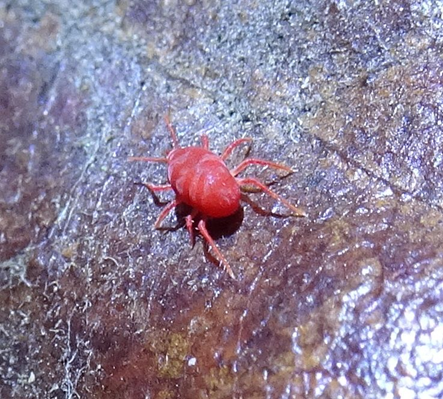
Snout mite (Acari: Bdellidae) Ian Cooper

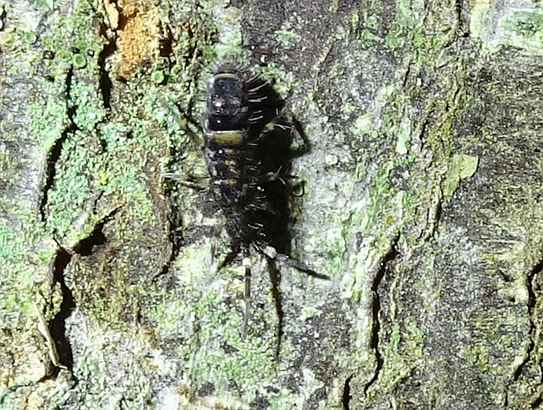
Springtail Orchesella villosa (Coll.: Orchesellidae)

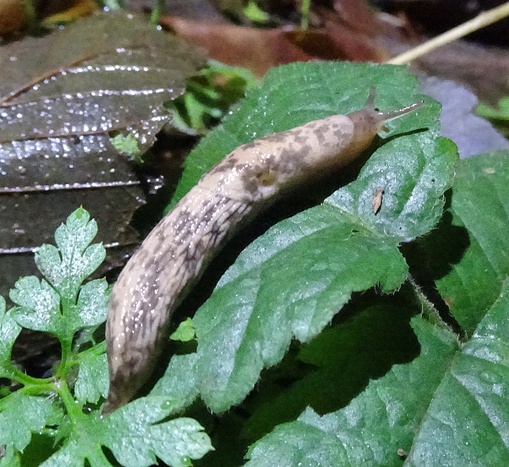
Deroceras reticulatum (Pul.: Agriolimacidae) Ian Cooper

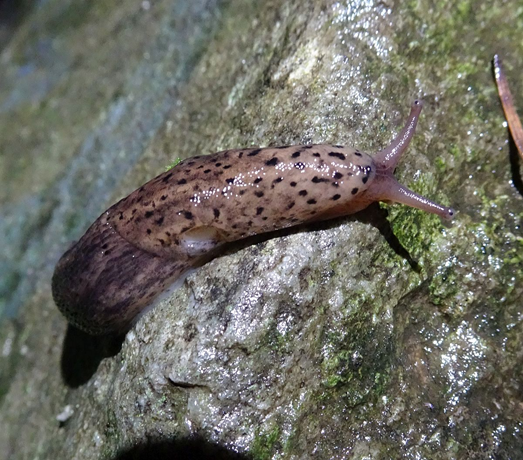
Limax maximus (Pul.: Limacidae) Ian Cooper

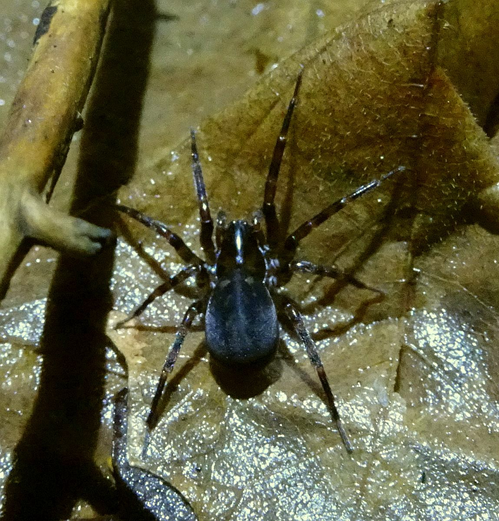
Cybaeus (probably signifer). (Ara.: Cybaeidae) Ian Cooper
Thanks to Dr Robb Bennett for the identifcation.

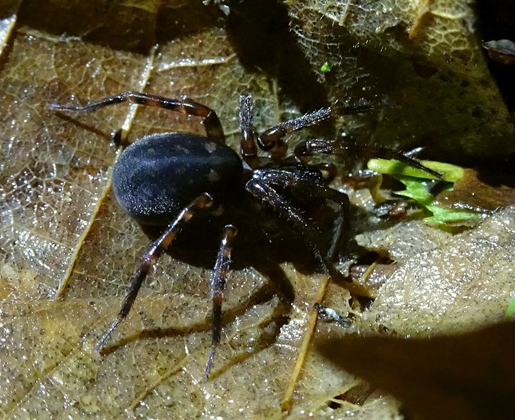
Cybaeus (probably signifer). (Ara.: Cybaeidae) Ian Cooper

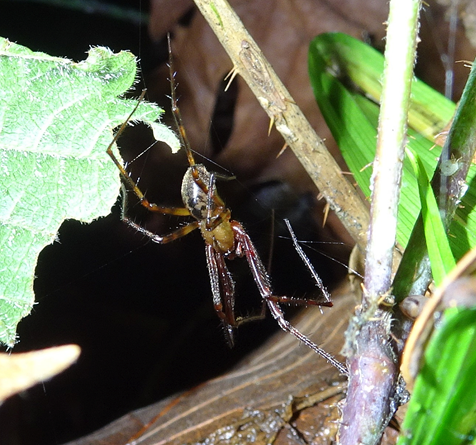
Pimoa altioculata (Ara.: Pimoidae) Ian Cooper
I don’t think we’ll try and identify the spider below – but it’s too nice to miss!

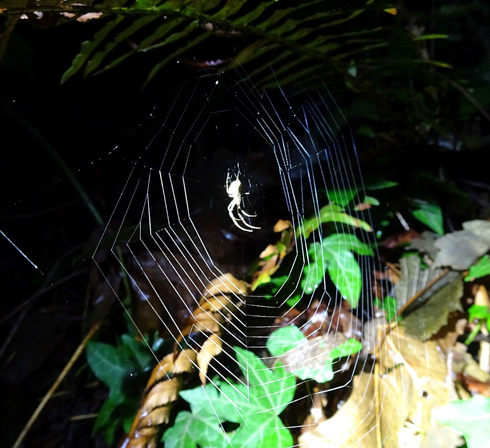
Orb weaver spider Ian Cooper
2020 December 30
Some frustratingly difficult Operophtera (Winter Moth) puzzles from Jochen Möhr in Metchosin today. Are they the native O. occidentalis, or the introduced European O. brumata? Jeremy Tatum writes: If the moth is rather uniformly grey or brown and unpatterned, I believe it to be O. brumata. O. occidentalis is usually heavily patterned – but O. brumata can be heavily patterned, too, so that makes things difficult. However, some well-patterned Operophtera have the middle terminal cell darker than the adjacent cells, and this middle terminal cell is often “grasped” by a dark H in the middle of the forewing. This creates an impression of a dark streak from the middle of the forewing to the middle of the outer margin, particularly obvious when viewed from a distance. I believe (though it may need DNA work to be certain) that these are O. occidentalis. I have labelled them below as best I can, but cannot guarantee!

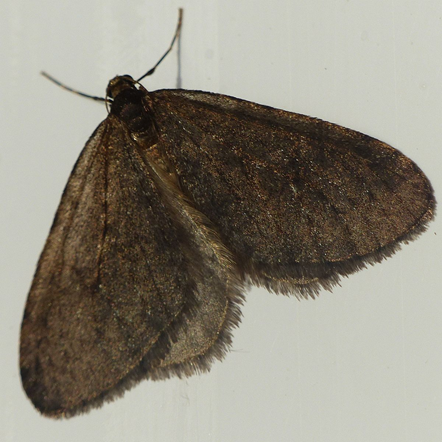
Operophtera brumata (Lep.: Geometridae) Jochen Möhr

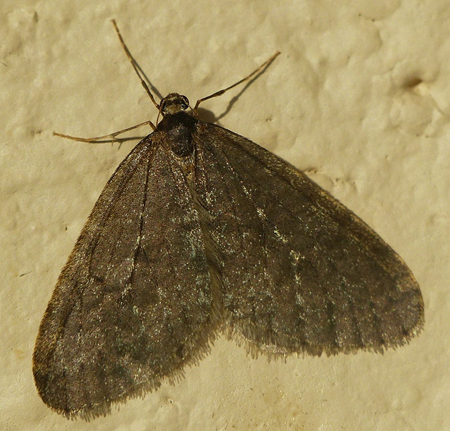
Operophtera brumata (Lep.: Geometridae) Jochen Möhr

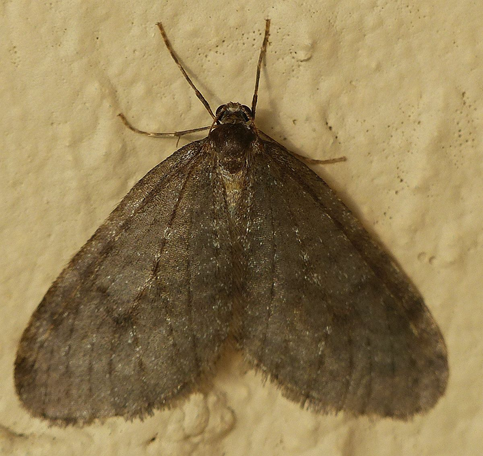
Operophtera brumata (Lep.: Geometridae) Jochen Möhr

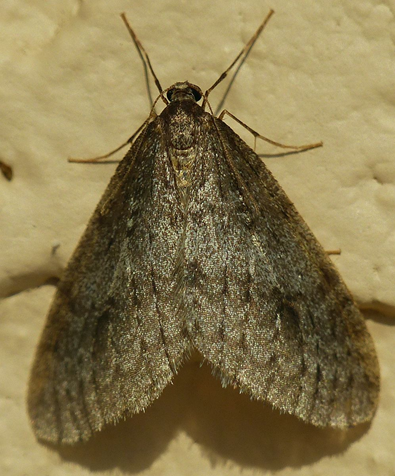
Operophtera sp. (not sure!) (Lep.: Geometridae) Jochen Möhr

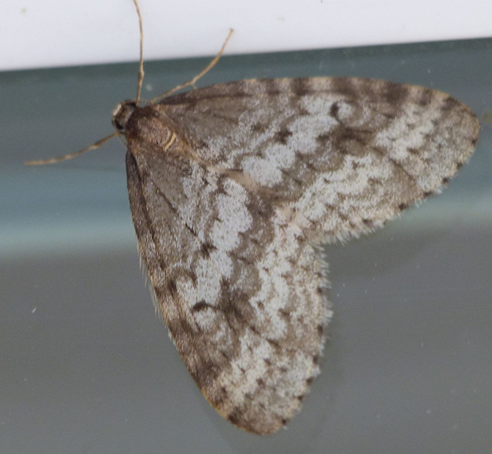
Operophtera occidentalis (Lep.: Geometridae) Jochen Möhr

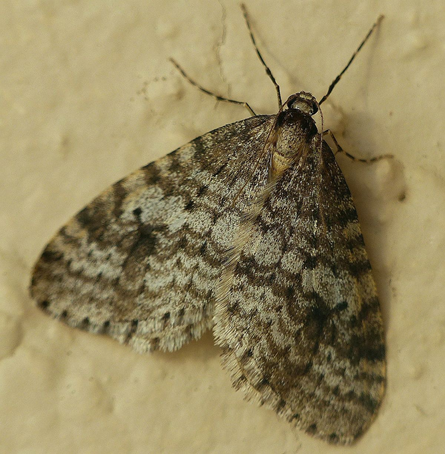
Operophtera occidentalis (Lep.: Geometridae) Jochen Möhr
And if these aren’t difficult enough, how about the next one! Because it is holding its wings in a more rooflike manner than geometrids usually do, it looked a slightly different shape than a typical winter moth (apparently narrower and more pointy wings), and deceived me into thinking that it was something totally different! Thanks to Jochen Möhr and Libby Avis for convincing me that it is Operophtera brumata again.

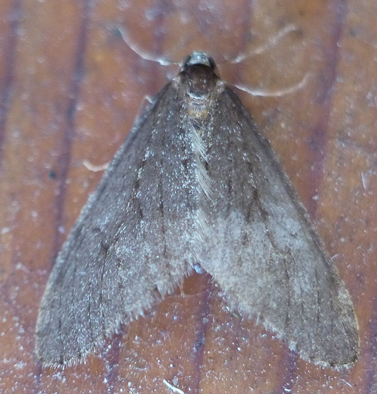
Operophtera brumata (Lep.: Geometridae) Jochen Möhr
More puzzles in line for tomorrow!
2020 December 28
Some spiders and a harvestman, photographed recently along Colquitz Creek or along the Galloping Goose trail by Ian Cooper, with comments or identifications by Dr Robb Bennett (spiders) and Dr Philip Bragg (harvestman). And a beetle, identification confirmed by Scott Gilmore.
Dr Bennett writes: The first three, and probably the fourth, are Pimoa altioculata. A very interesting genus of spiders.

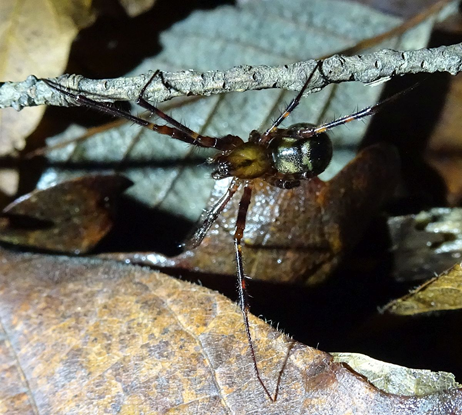
Pimoa altioculata (Ara.: Pimoidae) Ian Cooper

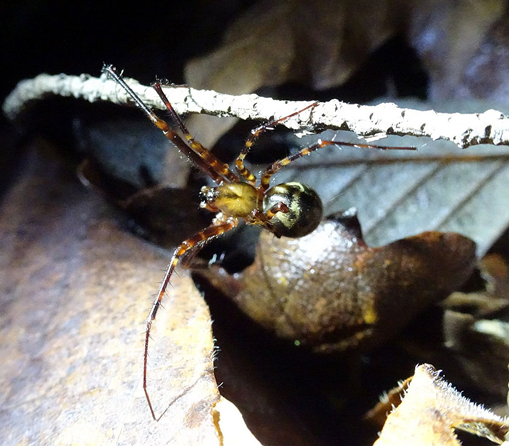
Pimoa altioculata (Ara.: Pimoidae) Ian Cooper

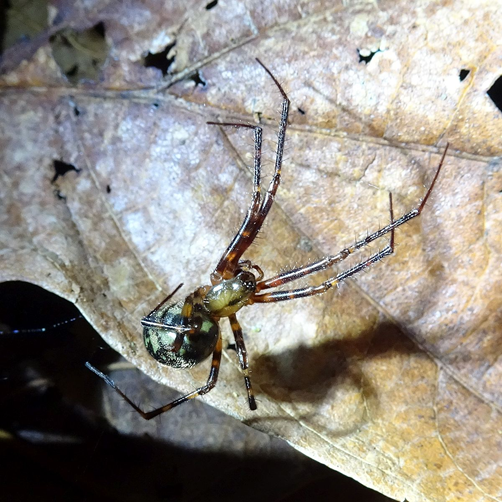
Pimoa altioculata (Ara.: Pimoidae) Ian Cooper

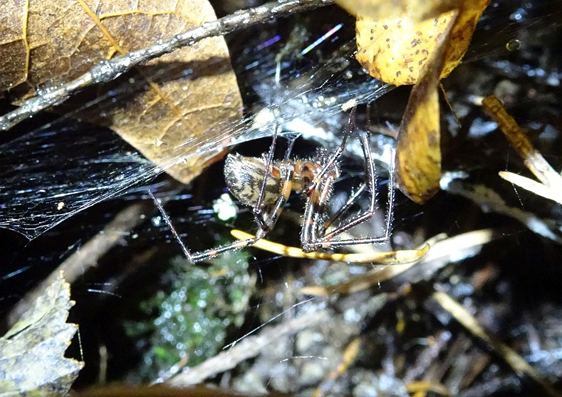
Probably Pimoa altioculata (Ara.: Pimoidae) Ian Cooper
The next two, continues Robb, are mature female and male linyphiines, I think a species of Neriene.
[Jeremy Tatum adds: I think Dr Robb probably identifies the sexes by (among other features) the size of the “boxing gloves” (pedipalps) – larger in the male.]

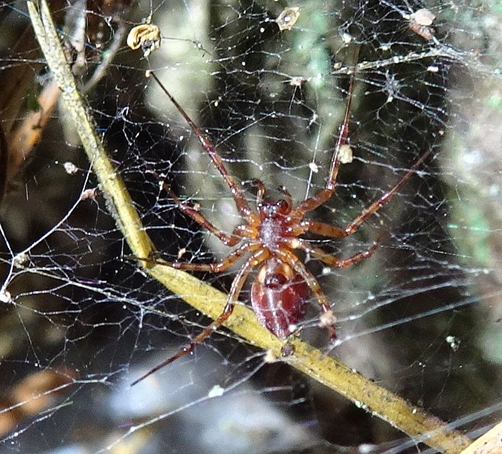
Female, probably Neriene (Ara.: Linyphiidae) Ian Cooper

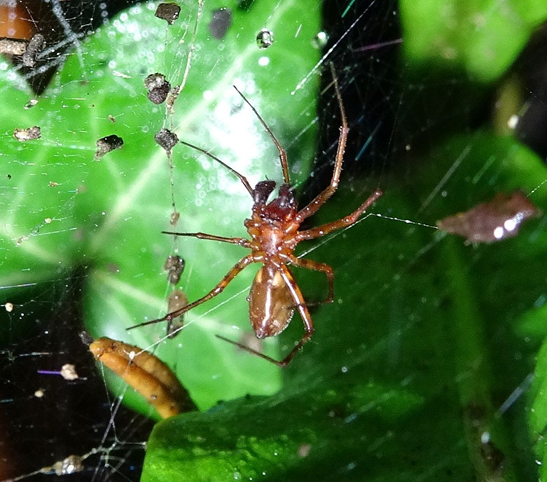
Male, probably Neriene (Ara.: Linyphiidae) Ian Cooper
Of the spider below, Dr Bennett writes: This is a species of Cybaeus, not sure which one—around here, reticulatus and eutypus are most common. And so is signifer but I think this beast is more likely to be reticulatus or eutypus.

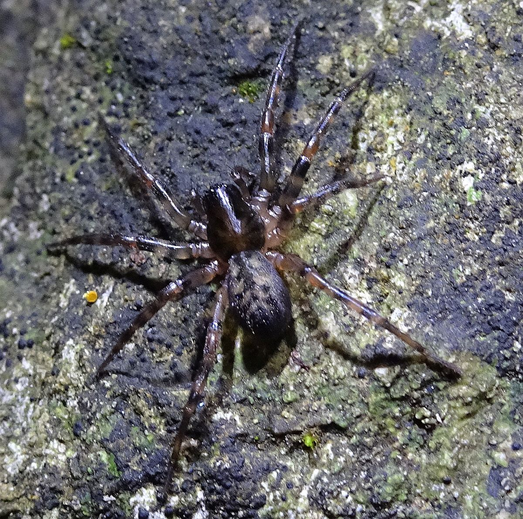
Cybaeus sp. (Ara.: Cybaeidae) Ian Cooper
Dr Bragg writes, of the harvestman below: One of the problems of showing the intact organism is that the depth of field is too great for sharp pictures. Another problem with harvestmen identification is that in many cases the specimen needs to be examined under the microscope to be sure. That said, I am not sure what species we have here. It is probably in the Subfamily Leiobuninae. It could be Nelima paessleri but I am not sure.

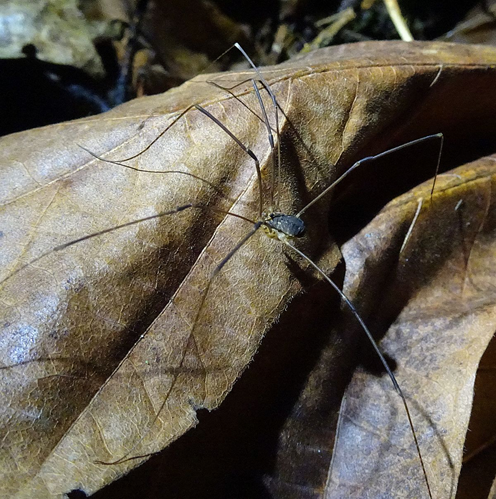
Harvestman. Possibly Nelima paessleri (Opiliones: Sclerosomatidae – Leiobuninae)
Ian Cooper

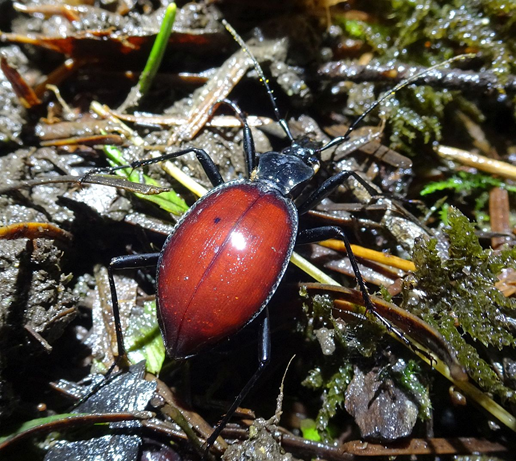
Scaphinotus angusticollis (Col.: Carabidae) Ian Cooper